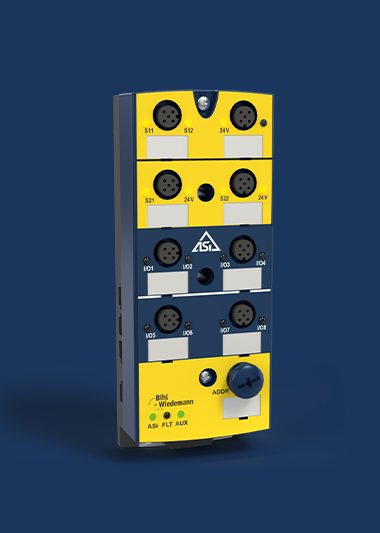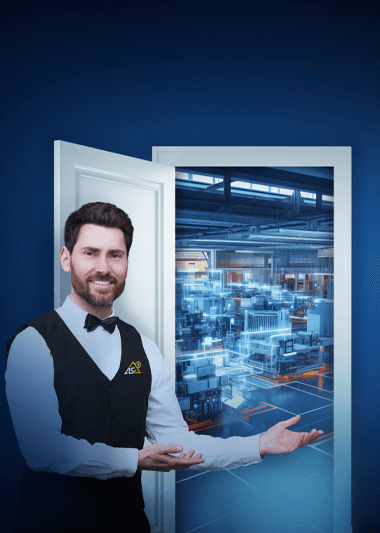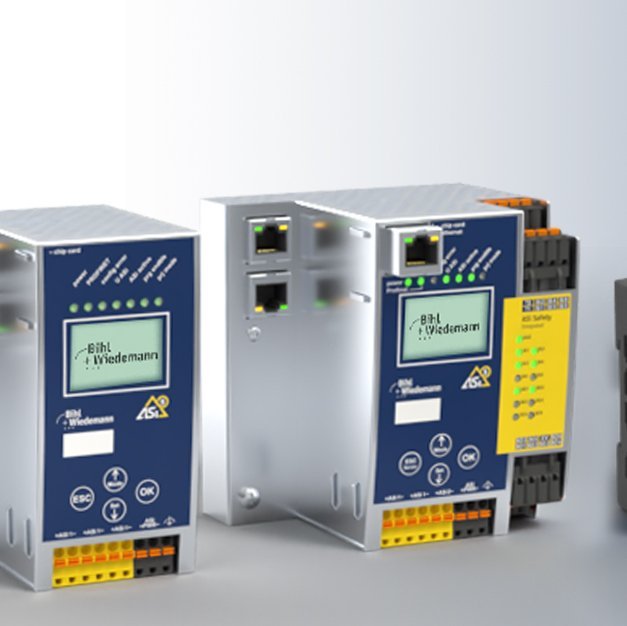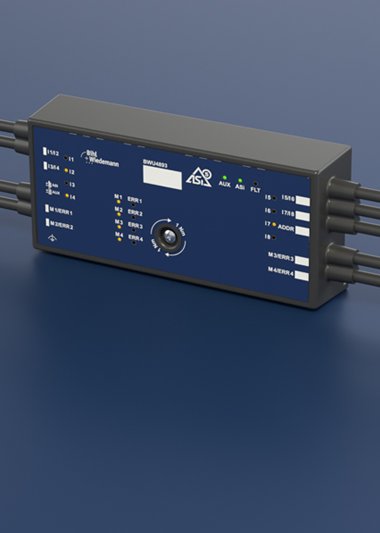- Interview
Interview with André Hartmann: ASi-5/ASi-3 Gateways – Edge devices for smart and safe automation
ASi MASTER NEWS: With the possibility of collecting safe signals and standard signals in the field at low cost using the AS-Interface wiring technology, material handling and material flow systems, packaging machine construction or process technology seem like obvious target industries. Were their requirements also the top priority in the development of the new ASi-5/ASi-3 gateways?
André Hartmann: Yes and no. Yes, because our development activities are very strongly customer-oriented. As a result, user and industry requirements are naturally always reflected in our products – in other words, including those from material handling or packaging technology. But also no because in conjunction with ASi-5, it is precisely customers from completely different industries who are placing higher demands on the automation potential of our devices in a wide variety of areas, especially in connection with IIoT.
Our current ASi portfolio clearly shows our commitment to versatility. Our ASi gateways, of which there is at least one variant with ASi-5 and OPC UA for almost every fieldbus, form the optimalIIoT interface into the field. There we have a wide range of safe and standard devices available for all kinds of applications – from the integration of IO-Link devices to drive control and complex safety applications.
ASi MASTER NEWS: And everywhere we are hearing increasing talk about connecting ASi-5 solutions in particular to the IIoT?
André Hartmann: Yes, the trend is unmistakable. Users are increasingly interested in gathering diagnostic information from drives or from IO-Link devices in the field and using them directly in applications within corporate IT or even in the cloud. IIoT interfaces such as OPC UA, but also other standards such as REST API and MQTT, can send this data bypassing the PLC.
Now you’re not impairing the performance of fieldbuses and automation systems due to an unnecessary communication load. At the same time, digital services can use this data directly, for example to monitor the operating behavior of conveyor drives or machine axes. This means our gateways are prepared to support not only OPC UA, but in the future REST API and MQTT if required, which provides multiple paths into the IIoT.
ASi MASTER NEWS: What other advantages do customers derive from your new gateway generation?
André Hartmann: For many, an important advantage is the fact that safe signals and standard signals can be collected and evaluated simultaneously in the ASi-5 circuits. The gateways with integrated ASi-5/ASi-3 Safety Monitor make machine safety easier, more cost-effective and more tailored than ever before. Power supply and communication are both on a single, yellow profile cable.
Connection using our piercing technology is simple and makes polarity reversal impossible. No more plugs, prassembled cables, special connection technology, or special switches are needed. It’s also quick and cost-effective to implement specific functions and applications. One example would be our new ASi-5 Safety Muting Module BWU4411. It’s simple and intuitive to configure, the configuration is automatically loaded and restored from the gateway in the event of replacement, it requires only a single ASi-5 node number for complete functionality, and it costs only about one- third of the solutions currently available on the market.
ASi MASTER NEWS: Conveyor systems, packaging machines and many applications in other industries work with Ethernet-based fieldbus systems. Wouldn't it be easier to collect the signals directly this way?
André Hartmann: At first glance, ASi-5 may appear to be just an additional bus system, which of course costs money. However, if you consider the time and cost involved in directly connecting many sensors and actuators along a conveyor line or in a packaging machine via Ethernet, or if you think about the many plugs and sockets you need for bus communication and the power supply, then things look quite different.
ASi is a complete wiring system, not just a bus technology, and that makes it unbeatable at the lowest field level: route the yellow cable, simply pin on the node, screw it down, and you're done. And unlike applications with Ethernet-based field modules, our range also allows for very fine-grained solutions. For example, IO-Link masters with one, two, four and eight ports are available for IO-Link integration. This means that there is no expense for ports or sockets that are not needed. In addition to cost-effectiveness, AS-Interface is also often favored for security reasons because some companies would rather not have any Ethernet sockets on a freely accessible machine or system, even if they are unused.
ASi MASTER NEWS: You mentioned the cost-effectiveness of ASi. To what extent does this depend on the size of the system?
André Hartmann: The more signals need to be collected in the field, the more economical ASi-5 is. The wiring technology scores particularly well when the components are distributed throughout the application with a distance of between one and five meters between them. In some systems, such as packaging machines with all their accesses and flaps, the signal density is often even greater.
And it’s frequently here that safety-related signals need to be collected, for which, in my view, there is no better solution than ASi Safety. Of course, this also applies to the collection of standard signals. But there are also special applications, such as on AGVs or other autonomous mobile equipment, where other functionalities, such as Safe Link via WLAN or safe speed detection of the system, are more relevant than just saving wiring costs and resources.
ASi MASTER NEWS: Predictive maintenance is still one of the most common applications of signals or IT data from the field. What trends do you see here, how is Bihl+Wiedemann positioned here?
André Hartmann: In addition to typical parameters such as temperature, vibration, pollution degree or power consumption, more and more measured variables will be added for condition monitoring in the future. In addition, we see new digital services also accessing other data in order to use them in their application. The IIoT is moving closer to the field level via OPC UA, REST API or MQTT – that's why we already have the interfaces on board of our ASi-5/ASi-3 gateways or have prepared them for this. We can already tell our customers today that we are technologically equipped for ongoing development in the IIoT, for example when processes like pattern recognition or artificial intelligence are used.
In addition, we have of course expanded and improved a number of functions in the new gateways. We have designed the diagnostic concept in the devices on multiple levels – and in doing so, we have discovered how important one very specific component still is for this: the display. There are many customers for whom the visual status display and fault diagnostics on the device are still the criterion that makes the difference. This is because regardless of the expertise of the maintenance technician, the display provides directly meaningful diagnostics using simple messages.
Of course, you can get even more tips on how to solve a problem via our web server or even from the diagnostic software, but this requires having a PC on site. In addition, you have to open an Ethernet connection to the gateway, which is not always so easy to do. If, for example, the signals from an ASi node stop coming, this not only lights up on the machine or gateway, but the machine operator or maintenance technician also receives a corresponding plain text message. Now you can eliminate the causes of simple faults in particular much more quickly – without the need for specialists and additional technical equipment, and without affecting the availability of machines and processes.
ASi MASTER NEWS: But shouldn't such plain text messages be a given for any machine visualization?
André Hartmann: In principle, yes, and it usually is the case. Our experience shows that machine builders often already implement these diagnostics very well for series machines. With single machines, on the other hand, it’s more often the case that the diagnostics in the visualization are only programmed very superficially and that people prefer to rely on the display of the field devices. And that's where the display of our ASi-5/ASi-3 gateways is literally 'worth its weight in gold', because it saves the machine or installation operator from unnecessary downtime and thus saves him money. And the visualization on the device also helps during commissioning, for example when assigning IP addresses, ASi-5 node numbers or for other service work.
ASi MASTER NEWS: Versatility, connectivity, cost-effectiveness, diagnostic convenience – with the ASi-5/ASi-3 gateways, Bihl+Wiedemann has put together a well-rounded and coherent technology package. Thank you very much for the interview.





